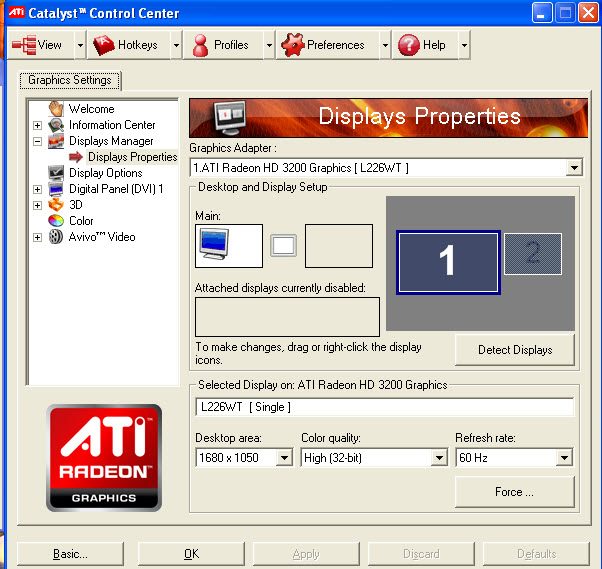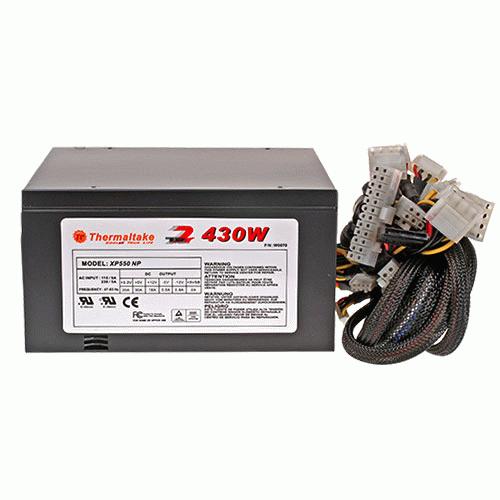Hi everybody
I want to connect my pc to the tv. I've connected the hdmi to the tv's hdmi, but when I go to video card properties, then I can only see 1 display, the tv is not listed there. Even if I search the source in the tv menu, I still can't see any connection to the pc.
What can it be wrong?
+ Reply to Thread
Results 1 to 21 of 21
-
-
Turn off the computer and TV. Connect the HDMI cable to both. Turn on the TV. Then turn on the computer. The computer should now detect the TV connected to the HDMI port and allow you to set up the dual display option.
-
thank. i've managed to connect them, but now I can only have picture either on the tv or on the pc monitor, but I want to have picture on both of them.Originally Posted by jagabo
One other thing, when I move a bit the cable from the back of the tv then the signal suddenly stops... -
one other thing, I don't have sound in the tv...
take a look here:
I can only see the pc monitor Lg, but not the tv...

-
Put the displays in "clone" or "mirror" mode -- I don't remember what ATI calls it.
Regarding sound, if the graphics card has a DVI output you generally don't get sound out of it. You have to use the digital or analog outputs from the sound card and run separate cables. If the card has an HDMI output you can usually set up the drivers to output digital audio over HDMI. You may have to install a special driver from the graphics card manufacturer. You sometimes have to run a digital audio cable from the sound card to the graphics card. -
What is this display card? Your profile says NVidia 7600GT.
What is the PC monitor native resolution? It appears to be 1680x1050.
What is the TV model number?
What is the TV monitor native resolution? Probably not 1680x1050.
Do you want the same picture on both (e.g. desktop), an extended desktop on the TV, or only play videos to the TV?Recommends: Kiva.org - Loans that change lives.
http://www.kiva.org/about -
on my device manager, ATI HDMI Audio has an exclamation mark.Originally Posted by jagabo
-
My display card is integrated in the motherboard and the motherboard is ASUS M4A78-EMOriginally Posted by edDV
The pc monitor native resolution is 1680x1050
The tv model number is: Samsung LE 32R71W
TV: it might be this one 1366 x 768 : here is a link with some details: http://www.shoppydoo.co.uk/price-lcd_plasma_televisions-samsung_le32r71w.html
I just want to play videos on my Tv, that's all. -
The Samsung LE 32R71W is 1366x768 native resolution.
You will need to operate in dual monitor mode with the second monitor set to 1366x768 and "Theater" mode. A laptop chipset may not suport these modes. Check the laptop documentation for dual monitor setup.
Theater mode plays media full screen on the TV and doesn't show the desktop.Recommends: Kiva.org - Loans that change lives.
http://www.kiva.org/about -
ATI cards are often picky about detecting TV display. Often looses setup after a power-off cycle. Having a loose cable which drops signal upon slight movement is going to complicate this problem.
First lock down that cable, or get a different one. Otherwise you are going to be tearing your hair out. -
Finding the answers to your questions probably requires looking at the user manual or online documentation for your motherboard.
Sometimes DVI-out and HDMI-out are implimented such that you can use only one of them at a time.
As far as sound, try using Windows' Control Panel to disable your speakers, enable HDMI audio, and set HDMI as the default instead of the speakers. That is the way it works for my new computer.
However, not all video cards transmit sound via HDMI. In that case, for audio you have to use the jack for your PC speakers, plus a right-left splitter cable to provide RCA audio jacks to connect your TV to the computer.
[edit]I found the manual for your motherboard online. It supports dual monitors, but one must be connected via VGA. The other can be connected using either HDMI or DVI-D. My motherboard uses a later Realtek audio driver. To get sound via HDMI, I had to configure the driver as described above. -
What does it mean that my amp "will not pass audio over hdmi"?Originally Posted by usually_quiet
-
Your amp? You mean your graphics card? If you meant the latter: as noted earlier some graphics cards require you run a digital audio cable from the sound card to the graphics card. Some graphics cards allow you to do this without a cable, with a driver that automatically takes digital data from the sound card and sends it to the HDMI port. The driver must be installed and the feature must be enabled.Originally Posted by alintatoc
-
It means that your amp will not pass audio over HDMI. Since no one has mentioned this, I will assume that you got this from your User Manual (gasp!) and it is most likely accurate.
You have and can identify an HDMI cable. You have and can identify AUDIO. You are apparently aware that with some equipment combinations, it is possible to PASS AUDIO OVER HDMI. The WILL NOT PASS part is a definitive, negative, absolute clarification. What is it exactly that you are failing to understand? -
To explain what I typed earlier, since it was not clear:
From what you wrote, you are using the integrated graphics and audio on your motherboard. The manual for your motherboard said you can only use dual monitors (or a TV and a monitor) if one of them is connected via VGA. I too have a PC that with an onboard ATI video chipset and an onboard Realtek audio chipset. Based on my own experience using HDMI with that PC, I suggested that you re-configure your audio output in Windows Control Panel to use HDMI not some other output device.
You don't use a separate card for either video or audio, so you don't need to connect spdif headers to a video card. Audio is probably available over the HDMI connection, but you first need to configure the audio driver to use that connection instead of your speaker jacks, or spdif. If that does not work you need to connect the TV to your PC using audio cables to have sound.
I am not sure you have tried to configure the audio driver to use HDMI, so here is what I did: Running Vista, I opened Windows Control Panel-->Hardware and Sound-->Sound-->Manage Audio Devices-->Playback. I disabled everything but HDMI sound, then made that the default. I only did this once so far, but it worked for me. When I was done using the TV, I had to go through the same process again and select my PC's speakers instead of HDMI to use my normal set-up. -
I want to buy a new graphic card ( ASUS EN9600GT Silent) but my power supply is only 400W and the minimum requirements from the ASUS EN9600GT Silent is 450W, what do you guys think? Will it work?
Here is a link with details about the graphic card : http://www.tweaktown.com/reviews/1506/asus_en9600gt_silent_graphics_card/index.html
One other thing, are all the new power supply units coming with cables like the ones that I attach in the image below?

-
Even if it works you'll likely be stressing your 400 watt PSU. Be sure the card will fit in your case.
I've been using an 8600GT Silent in my HTPC for a few years. Be sure you have sufficient case cooling. -
I have the Antec P180 mini, which has 2 fans, one fan on top which is 20cm, and one in the back which is 12 cm.Originally Posted by jagabo
Will that be enough?
Similar Threads
-
Need help to setup
By thecaveman in forum Newbie / General discussionsReplies: 2Last Post: 15th Sep 2010, 13:35 -
Playing Video on display 2 and display 1 goes black
By sidewaysdriver in forum Software PlayingReplies: 2Last Post: 3rd Aug 2010, 00:36 -
What setup is this?
By therock003 in forum AudioReplies: 12Last Post: 5th Jan 2010, 05:58 -
Help with HD Setup
By 24inchdubz in forum DVB / IPTVReplies: 1Last Post: 8th Jul 2009, 21:13 -
Best Setup For My Needs
By ginakra in forum DVD & Blu-ray RecordersReplies: 5Last Post: 22nd Apr 2008, 08:11



 Quote
Quote